
views
- Start by diagramming a simple sentence with a subject, verb, and direct object. For example, the sentence “Students read books.”
- Draw a horizontal line that’s split in the middle by a vertical line. Write the subject on the left side of the vertical line and the verb on the right side.
- On top of the horizontal line, draw another vertical line on the right side of the verb. Write the direct object on the right side of this new vertical line.
How to Diagram a Simple Sentence
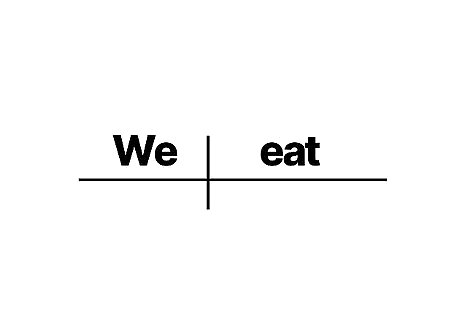
Diagram the subject noun and predicate verb. Draw a horizontal line with a small vertical line through the middle. To the left of the vertical line, write your subject. To the right of the vertical line, write your verb. This is the most basic complete sentence.

Add the direct object. Draw another vertical line going upward from the horizontal line. To the right of this line, write the direct object.Vegetables disgust Felipe. In the above sentence, Vegetables disgust Felipe: The subject is “vegetables.” The verb is “disgust.” The direct object is “Felipe.”

Add the indirect objects beneath the verb. Draw a small horizontal line under the verb and connect it to the base line with a diagonal line. In general, indirect objects could include a preposition, and so are drawn with a diagonal line coming off of the word they modify. See Step 6 for prepositions. The farmers gave their kids fresh vegetables. In the above sentence, The farmers gave their kids fresh vegetables: The subject is “farmers.” The verb is “gave.” The direct object is “vegetables.” The indirect object is “kids.” The article is “the.” The possessive pronoun is “their.” The adjective is “fresh,” which modifies “vegetables.”

Draw a slash to add a predicate nominative or predicate adjective. A predicate nominative is a noun, pronoun, or adjective that refers to the subject. The verb preceding the predicate nominative or adjective is usually a linking verb, such as the forms of to be (is, are, was, etc.) or sense words (looks, smells, tastes, etc.). To the right of the slash, write the predicate nominative or adjective.Vegetables are disgusting. In the above sentence, Vegetables are disgusting: The subject is “vegetables.” The linking verb is “are.” The predicate adjective is “disgusting.” Note that pronouns following linking verbs should be in the nominative case: This is she or It is I rather than This is her or It is me.

Add modifiers and articles. Place adjectives, adverbs, articles, and possessives on diagonal lines below the words they modify.The green vegetables are always disgusting. In the above sentence, The green vegetables are always disgusting: The subject is “vegetables.” The linking verb is “are.” The predicate adjective is “disgusting.” The adjective is “green,” which modifies “vegetables.” The article is “the.” The adverb is “always,” which modifies “disgusting.”
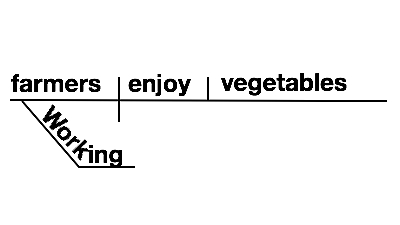
Add a participle on a bent line beneath the word it modifies. Write the participle as a curved word on this slanted line, as shown in the example below.Working farmers enjoy vegetables. In the above sentence, Working farmers enjoy vegetables: The subject is “farmers.” The participle is “working,” which modifies “farmers.” The verb is “enjoy.” The object is “vegetables.”

Add a preposition. Draw a diagonal line coming down from the word it modifies, whether a verb or adjective or other part of speech. Write the preposition on this diagonal line. Draw a horizontal line coming off the preposition line. Write the object of the preposition on this horizontal line.The kids threw the vegetables in the trash. In the above sentence, The kids threw the vegetables in the trash: The subject is “kids.” The verb is “threw.” The direct object is “vegetables.” The preposition is “in.” The object of the preposition is “trash.” The article(s) are every instance of “the.”
Advanced Sentence Diagramming

Diagram a compound sentence made up of two independent clauses. Add the conjunction on a bent, broken line. In the above sentence, The green vegetables are always disgusting, and I hate them, there are two independent clauses. The subject of the first clause is “vegetables,” the verb is “are,” the predicate adjective is “disgusting,” the article is “the,” the adjective is “green,” and the adverb is “always.” The subject of the second clause is “I,” the verb is “hate,” and the direct object is “them” (a pronoun referring to the already-stated “vegetables”). The two clauses are linked by the coordinating conjunction “and.”

Diagram a simple sentence that includes a conjunction by splitting the line. Then, join the split lines with a broken line. This format is used if the conjunction is joining words within a simple sentence.I like fruits and vegetables. Green and yellow vegetables are always disgusting. In the first of the above sentences, I like fruits and vegetables, the subject is “I,” the verb is “like,” the two direct objects are “fruits” and “vegetables,” and the conjunction is “and,” which joins the two direct objects. In the second of the above sentences, Green and yellow vegetables are always disgusting, the subject is “vegetables,” the verb is “are,” the predicate adjective is “disgusting,” the adverb is “always” (modifying “disgusting”), the adjectives are “green” and “yellow” (modifying “vegetables”), and the conjunction joining the adjectives is “and.”

Draw appositives in parentheses next to the words they modify. Appositives are words that redefine or rename other words. Appositives can be separated in sentences using colons, dashes, or parentheses and do not change the meaning of the sentence. Adjectives and articles that apply to the appositive are drawn beneath the appositive word. In the above sentence, An unabashed herbivore, I like fruits and vegetables: The subject is “I.” The verb is “like.” The direct objects are “fruits” and “vegetables.” The conjunction joining the direct objects is “and.” The apposition to “I” is “herbivore.” The article is “an.” The adjective is “unabashed,” which modifies “herbivore.”

Place infinitive phrases on a separate line beginning with a diagonal. This infinitive line is called a “pedestal.” Infinitives are the basic forms of verbs, often beginning with the word to, as in to see or to walk or to eat. In the above sentence, I like to eat vegetables, the subject is “I,” the verb is “like,” and the infinitive phrase is “to eat vegetables.” The infinitive phrase “to eat vegetables” is made up of the infinitive verb “to eat” and the object “vegetables.”

Draw a staircase for gerunds. Gerunds are verbs ending in -ing that act as nouns but often take direct objects. They are usually drawn on a pedestal or stepped line. In the above sentence, Eating vegetables is good for you, the object is “vegetables,” the linking verb is “is,” the predicate adjective is “good,” the preposition is “for,” and the object of the preposition is “you.” The gerund phrase is “eating vegetables,” which is made up of the gerund “eating” and the object “vegetables.” Gerunds can also function as objects of prepositions. When functioning as the object of a preposition, gerunds do not need a pedestal.You can achieve a healthier lifestyle by eating vegetables. In the above sentence, You can achieve a healthier lifestyle by eating vegetables, the subject is “you,” the verb phrase is “can achieve,” the direct object is “lifestyle,” the preposition is “by,” the article is “a,” and the adjective is “healthier” (modifying “lifestyle”). The gerund phrase is “eating vegetables,” which is made up of the gerund “eating” and the object” “vegetables.”

Draw noun phrases on pedestals. That, and other expletives like which, can introduce a noun phrase. In the above sentence, I wish that she ate more vegetables, the subject is “I” and the verb is “wish.” The noun clause, “that she ate more vegetables” is introduced by the expletive “that.” The noun clause is made up of the subject “she,” the verb “ate,” the direct object “vegetables,” and the adjective “more.” Noun phrases do not always need an expletive. Sometimes it is simply understood, such as the implied “that” in the sentence I wish she ate more vegetables. When the expletive is understood, draw an X in parentheses where the word would go.
Understanding Grammatical Parts
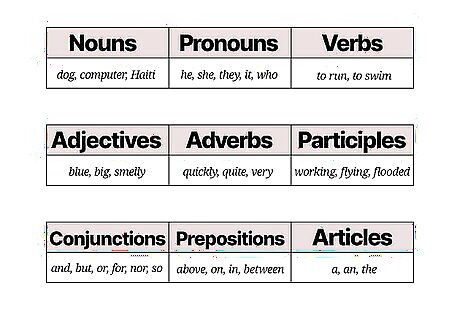
Review the parts of speech. Understanding how to identify a noun, pronoun, verb, adjective, conjunction, preposition, etc. is essential to sentence diagramming. Nouns: Words representing people, places, things, or ideas, e.g. dog, computer, Haiti, teacher, and dream. Pronouns: Word that represent nouns, e.g. he, she, they, it, or who. Verbs: Action words, e.g. to run, to swim, and to fly. Adjectives: Describing words that apply to nouns, e.g. blue in blue water, big in big baby, and smelly in smelly garbage. Adverbs: Describing words, like adjectives. However, adverbs apply to verbs, adjectives, and other adverbs. E.g. quickly in quickly run, quite in quite slowly, and very in very beautiful. Participles: Words formed from verbs that act like adjectives or nouns, e.g. working in working farmers, flying in flying birds, and flooded in flooded basement. Conjunctions: Words that join clauses or words within the same clause, e.g. and, but, or, for, nor, so, and yet. Joining independent clauses: "Jalissa took the car keys and she drove to work." Joining words in the same clause: "Arturo likes apples and oranges equally." Prepositions: Words that tell you how nouns in a sentence relate to one another, whether by direction, time, location, or space. E.g. above, on, in, between, through, and to, among others. Articles: Words that modify nouns, making them specific or unspecific: a and an (unspecific), the (specific).
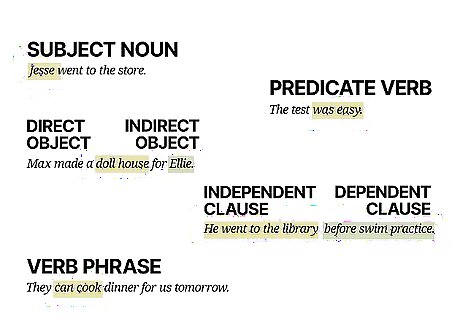
Review other grammatical components. Some of these are related to parts of speech, while others are more advanced concepts that add meaning and complexity to a sentence. All of these components and their purposes are necessary to understand before you start to diagram sentences. Subject noun: The subject of a sentence is the doer of the action in the sentence. E.g. “Jesse” in Jesse went to the store. Predicate verb: The part of a sentence that tells us the complete action of the sentence, which includes the main verb/action. E.g. “was easy” in The test was easy or “knows my father” in The man in the car knows my father. Direct object: The noun that receives the action, e.g. “doll house” in Max made a doll house for Ellie. Indirect object: The noun that receives the direct object, e.g. “Ellie” in Max made a doll house for Ellie. Independent clause: A clause that can stand alone as a sentence, e.g. "He went to the library. Dependent clause: A clause that must join an independent clause to become a complete sentence, e.g. “before swim practice” in He went to the library before swim practice. Verb phrases: Main verbs, like lift, cook, or drive, that have been paired with auxiliary, or helping, verbs, like will, can, or may, which create a sense of time and mood in English sentences. In the following examples, the main verbs are bold and the auxiliary verbs are italic. The two combined make the verb phrase. Note that adverbs are not part of the verb phrase, even if they occur between the auxiliary and main verbs. She will lift the box. They can cook dinner for us tomorrow. You may not have dessert. (Not is not part of the verb phrase). Sam would have liked this movie. (Depending on the intent, auxiliary verbs can be strung together.)

Practice identifying grammatical parts by analyzing sentences. It is much easier to diagram a sentence if you already have an idea of the grammatical contents of that sentence. You can write out and label the different words in the sentence, or you can mentally note which words serve what purpose. Some words are difficult to parse, so save those for last. Determine your subject and verb. These are the foundations of a sentence and, thus, the foundations of a sentence diagram. The subjects of the following sentences are bold, and the main verbs are italic. Children will listen. Though John doesn't like broccoli, he will eat other vegetables. Vegetables disgust Felipe. Felipe was disgusted by vegetables. Ira gave Cho her necklace. Find the direct object if there is one. From the above examples, Children will listen does not have a direct object, but Vegetables disgust Felipe does. Felipe is the direct object of the verb disgust.



















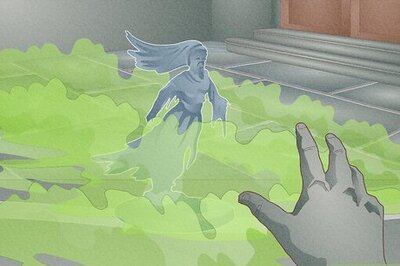
Comments
0 comment